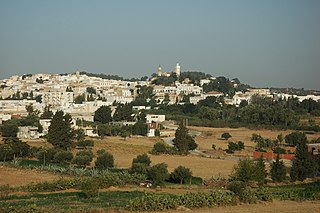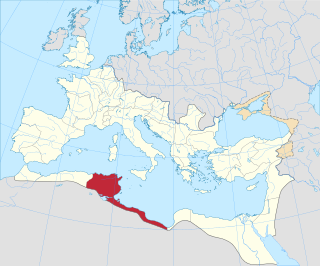
Zaghouan is a town in the northern half of Tunisia.
Usilla or Usula was a town in the Roman province of Byzacena, now Inchilla in Tunisia.

Thelepte was a city in the Roman province of Byzacena, now in western Tunisia. It is located near the border with Algeria about 5 km north from the modern town of Fériana and 30 km south-west of the provincial capital Kasserine.

Quiza also known as Vuiza (Βούϊζα), which Pliny the Elder called Quiza Xenitana, was a Roman–Berber colonia, located in the former province of Mauretania Caesariensis. The town is identified with ruins at Sidi Bellater, Algiers.

Pupput, also spelled "Putput", "Pudput", "Pulpud" and "Pulpite" in Latin, sometimes located in Souk el-Obiod ou Souk el-Abiod, is a Colonia in the Roman province of Africa which has been equated with an archaeological site in modern Tunisia. It is situated on the coast near the town of Hammamet, between the two wadis of Temad to the north and Moussa to the south. Much of the Pupput is buried under modern holiday developments which have been built over the major part of the site.

Aquae Sirenses, also known as Aquaesirensis, is an ancient Roman colonia and a modern titular see of the Roman Catholic Church in Algeria.

Turrisblanda, was a Roman and Byzantine era colonia (town) in the Roman Empire province of Byzacena in what is today modern Tunisia. Its exact location remains unknown. It was also a capital of an historic diocese of the Roman Empire. The bishopric remains today as a titular see of the Roman Catholic Church. The current bishop is Jan Szkodoń, Auxiliary Bishop of Cracow.

Unizibira was an ancient town and bishopric in Roman North Africa which remains a Latin Catholic titular see.
Tigisis, also known as Tigisis in Mauretania to distinguish it from another Tigisis in Numidia, was an ancient Berber town in the province of Mauretania Caesariensis. It was mentioned in the Antonine Itinerary.

Abthugni was an ancient city in Roman North Africa at present day Suwar (Henchir-es-Souar) in Tunisia. It was, in Roman times, in the province of Africa Proconsularis, Africa, and latter in Byzacena. In late antiquity Abthugni was also the seat of a bishop, and the diocese is a titular see of the Roman Catholic Church to this day.

Vegesela in Byzacena was a Roman Era town tentatively identified with ruins at Henchir-Recba in modern Tunisia. The town was in the Roman province of Byzacena.

Auzegera was a Roman-Berber town in the province of Africa Proconsularis and in late antiquity Byzacena. It was a Catholic Church diocese.

Crepedula was an ancient Roman–Berber civitas in the province of Byzacena in Africa Proconsularis. It was located in modern Tunisia. The town was also the seat of a Catholic diocese.
Cabarsussi was an ancient civitas (municipality) and bishopric in the Roman province of Byzacena, that is tentatively identifiable with ruins at Drâa-Bellouan in modern Tunisia. The current bishop is Terence Robert Curtin, auxiliary bishop of Melbourne.

Muzuca was a Roman Town of the Roman province of Byzacena during late antiquity. The town has tentatively been identified with the ruins at Henchir-Besra in modern Tunisia. Very little is known of the city, though in situ epigraphical evidence gives us the name and that in late antiquity it achieved the status of Municipium.
The diocese of Garba is a suppressed and titular see of the Roman Catholic Church.

Marazanae was a Roman town of the Roman province of Byzacena during the Roman Empire and into late antiquity.
The diocese of Presidio is a suppressed and titular see of the Catholic Church.
The Diocese of Thiges was a Roman Catholic diocese in ancient Byzacena.
The Dioces of Thysdrus is a suppressed and titular See of the Roman Catholic Church.











